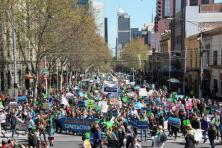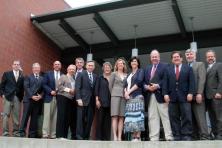In the September 15 issue of The Atlantic magazine, Brookings expert Bruce Katz called out a “metropolitan moment,” in which municipal and regional leaders are “adapting the discipline of private sector business planning…to the task of revitalizing and restructuring metropolitan economies.”
Meanwhile, on September 25 Neil Peirce charted the potential of partnerships between local government and business to make good on an emerging concept of “climate prosperity.” Peirce described the trend that “a growing number of Main Street and regional business leaders, types often viewed as Republican-leaning, are taking [climate change] ever-more seriously, if not to save the world, at least to serve their bottom lines.”
Combined, these two insights equal a powerful observation that cities can and even must serve as anchors for America’s clean energy economic development. As Katz quoted Colorado Governor and former Denver Mayor John Hickenlooper, “collaboration has become the new competition.” The result of Hickenlooper’s approach speaks for itself, in the form of Denver’s world-class green urban development.
For local government officials, the upshot of this way of thinking is that clean energy investment goals may be met most effectively through partnership that involves not only agencies with sustainability in their DNA (like public works and environmental management), but also economic development officials, captains of local industry, and heads of civic institutions, like hospitals and public housing authorities.
To date, state governments have received much credit for building the clean energy economy in the absence of federal policy, but local governments deserve equal recognition for this challenging work. Even before 2005, when mayors nationwide signed the US Mayors Climate Protection Agreement, cities and counties were accounting for their greenhouse gas emissions, testing new clean energy technologies in their buses, and turning waste gas into energy, all in the absence of federal action on climate change.
And while not passing climate change legislation, the US federal government has lent some support to cities for clean energy innovation.
- In 2009, through the American Recovery and Reinvestment Act (Recovery Act), the Energy Efficiency and Conservation Block Grant (EECBG) funding from the Department of Energy (DOE) unleashed a veritable flood of pent-up energy innovation at the local government level. For cities and counties across the country who had saved up several fiscal years’ worth of government-greening ideas, EECBG was just the enabling opportunity they had been awaiting. Local teams used these and other funds to begin energy upgrades of municipal facilities, community spaces, and housing across the country – in aggregate, a massive national undertaking that created thousands of jobs in cities that needed them. Las Vegas, Nevada used its $5.4 million in EECBG funding to leverage an additional $20.4 million to fund energy efficiency retrofits and small-scale solar energy projects, among other energy-saving measures. Many cities, like Delray Beach, Florida, hired Sustainability Officers to develop comprehensive energy, sustainability, and climate goals and related implementation plans.
- In 2007 and 2008, DOE’s Solar America Cities program designated 25 cities nationwide to develop model partnerships that would involve local and state agencies, solar companies, utility companies, and nonprofit organizations, to remove barriers and encourage the adoption of solar energy by city residents and businesses.
- Meanwhile, DOE’s Clean Cities program has built a network of 100 coalitions around the country, all committed to cross-sectoral partnerships that employ emerging vehicle technologies and innovative approaches to transportation emissions reduction.
Unfortunately, these programs alone have not provided what is ultimately necessary to reduce the greenhouse gas emissions from America’s cities and resuscitate the green economic development that was initiated through the Recovery Act. EECBG was a one-time DOE program under the Recovery Act, not likely to be renewed any time soon. Solar America Cities has since evolved into the Solar America Communities Outreach Partnership, a worthwhile effort that is now expanded to include rural communities but no longer provides funding. Clean Cities remains intact but is focused on transportation alone.
Now, with fiscal austerity measures looming large, how will cities fare in executing their clean energy plans? Instead of closing up shop, a robust ecosystem of non-profit “brokers” has continued to grow in response to steady city demand for solutions:
- The New Energy Cities team has partnered with mayors across the Northwest to host two-day workshops in seven small- to medium-sized cities to date, resulting in clean energy Roadmaps and associated Action Plans with key implementation priorities identified for prospective catalytic clean energy projects.
- Nationally, the Efficiency Cities Network offers “an informal policy learning network of government staff, researchers and technical assistance providers, and NGOs currently active in or committed to making scaled efforts at high-road energy retrofits of urban building stock.” Along similar lines, Chicago-based CEOs for Cities provides a “civic lab” for urban leaders across the US to stay updated on cutting-edge ideas in urban development.
- Globally, the Clinton Climate Initiative and C40, a group of cities around the world committed to climate action, helps large cities develop and deliver innovative programs to reduce greenhouse gas emissions.
- ICLEI – Local Governments for Sustainability continues to provide cities around the world with advice on carbon accounting and reduction, supported by strong peer-to-peer learning.
- The Global Smart Cities Association (GSCA) promotes cooperation between cities and corporations to promote innovation, in support of economic development. GSCA will host a Smart City Expo in Barcelona on November 29, 2011 to provide a meeting point for these types of partnerships.
These and other organizations recognize local governments’ potential to be the conveners of clean energy economic development, even when fiscal constraints prevent them from being direct funders. Opting for this “soft” convening approach may seem necessary in lean budget times, but it also represents the best of what local governments have to offer: a bird’s eye view of community priorities, and the necessary levers of change—from permitting to business relationships—to make the clean energy economy real.



